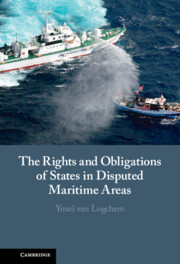Book contents
- The Rights and Obligations of States in Disputed Maritime Areas
- The Rights and Obligations of States in Disputed Maritime Areas
- Copyright page
- Contents
- Preface and Acknowledgements
- Cases
- Treaties and Legislation
- Abbreviations
- 1 Introduction
- 2 Disputed Maritime Areas: Setting the Scene
- 3 Disputed Maritime Areas: General Rules of International Law
- 4 Disputed Territorial Sea and Contiguous Zone Areas: Applicable Conventional Rules
- 5 Disputed EEZ and Continental Shelf Areas: Applicable Conventional Rules
- 6 Case Law Involving the Rights and Obligations of States in Disputed Maritime Areas
- 7 Disputed Waters Generated by Claims Made from Disputed Land Territory: What Are the Rights and Obligations of States?
- 8 Acts of Unilateralism in Disputed Maritime Areas: A Survey of State Practice
- 9 Are the Rights and Obligations of States in Disputed Maritime Areas Sufficiently Defined in International Law?
- Index
7 - Disputed Waters Generated by Claims Made from Disputed Land Territory: What Are the Rights and Obligations of States?
Published online by Cambridge University Press: 01 October 2021
- The Rights and Obligations of States in Disputed Maritime Areas
- The Rights and Obligations of States in Disputed Maritime Areas
- Copyright page
- Contents
- Preface and Acknowledgements
- Cases
- Treaties and Legislation
- Abbreviations
- 1 Introduction
- 2 Disputed Maritime Areas: Setting the Scene
- 3 Disputed Maritime Areas: General Rules of International Law
- 4 Disputed Territorial Sea and Contiguous Zone Areas: Applicable Conventional Rules
- 5 Disputed EEZ and Continental Shelf Areas: Applicable Conventional Rules
- 6 Case Law Involving the Rights and Obligations of States in Disputed Maritime Areas
- 7 Disputed Waters Generated by Claims Made from Disputed Land Territory: What Are the Rights and Obligations of States?
- 8 Acts of Unilateralism in Disputed Maritime Areas: A Survey of State Practice
- 9 Are the Rights and Obligations of States in Disputed Maritime Areas Sufficiently Defined in International Law?
- Index
Summary
Disputes where title over high-tide features or mainland territory is disputed are not uncommon in the international legal landscape. Two sets of overlapping claims are created in disputes in which the issues of dispute to title and disputed waters are combined: one set that pertains to the land territory as such, and the other to the maritime zones the land territory is entitled to. Sovereignty claims by States to a high-tide feature or land territory are almost invariably followed by making claims to the maritime zones that they are entitled to, thereby creating a second layer of overlapping claims that relate to the adjacent waters. But what are the rights and obligations of States in disputed waters located off disputed land territory? This chapter establishes the implications that follow from that there is a combination of the elements of sovereignty and the claiming of maritime zones from the same basepoints of a disputed land territory, for identifying the applicable legal framework in disputed waters off its coast. For example, the applicability of Articles 74(3) and 83(3) LOSC is limited in cases where claims are measured from the same disputed land territory, creating disputed waters in the process.
Keywords
- Type
- Chapter
- Information
- The Rights and Obligations of States in Disputed Maritime Areas , pp. 239 - 248Publisher: Cambridge University PressPrint publication year: 2021



